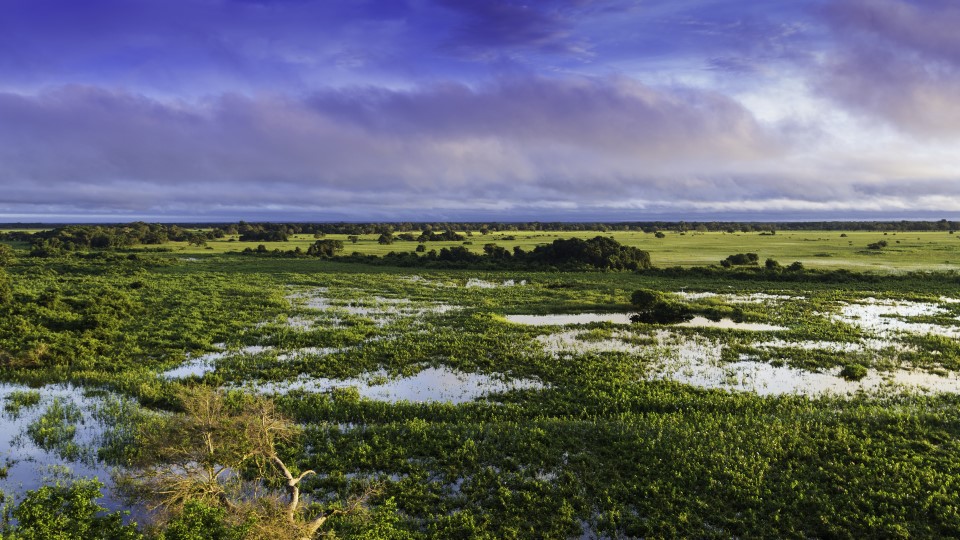Brazil: Devastating fires in the Earth's largest wetland

The worst fires ever recorded in the first half of the year are currently raging across Brazil’s Pantanal region – the largest inland wetland in the world. The seasonally recurring fires have begun significantly earlier this year and are far greater in scope than usual. Brazil’s National Space Research Institute (INPE) monitors deforestation and reported the fires last Tuesday. The current numbers indicate that it may be a record year for fires in the ecosystem.
In the first half of this year alone, 3,538 fires were recorded – the highest number since recording began in 1999. The previous record was set in 2020, when 2,534 fires were registered in the first six months of the year: almost 30 percent of the Pantanal was affected. Experts now expect an even more devastating scenario.
Usually fire season in western Brazil’s Pantanal region doesn’t begin until the dry season sets in, typically between late July and August. But this year there were 2,639 fires in June alone – a month that in previous years saw on average only 154 blazes.
Drought and human-caused fires
According to government reports, the large number of fires this year is the result of several factors. Chief among them is a prolonged drought that set in three months before the usual dry period. “The Pantanal is facing its longest period of drought in 70 years, exacerbated by climate change and one of the strongest El Niño’s in history,” Brazil’s environmental ministry said last Sunday. The Geological Survey of Brazil reported last month that almost every major river in the region was experiencing below-average water levels for this time of year.
Some regions of the Pantanal could suffer significant damages, according to IBAMA, part of Brazil’s Ministry of the Environment. “After these types of catastrophes, nature bounces back in many regions. But in some areas the losses are substantial. In some places they could even be irreversible. We are very shocked by the fact that for the sixth year in a row, the Pantanal is not experiencing a flood season,” IBAMA president Rodrigo Agostinho told the news site G1.
So far this year, nearly 700,000 hectares (1.7 million acres) have burned – almost 5 percent of the entire Pantanal region.
Agostinho suspects that some of the fires were caused by criminal activity. Renata Libonati, a meteorology professor and coordinator of a fire alert system in the Pantanal, told the Associated Press (AP) that the majority of fires currently burning in the region were very likely caused by humans and not by natural causes like lightning. According to official data, 85 percent of the fires originated on private property.
Invisible blazes
The military is working alongside firefighters to help contain the flames. Firefighting planes have been deployed. The Brazilian government has also dispatched 285 officials from various agencies as well as 82 members of the national guard to support local firefighters, the AP reported last Saturday.
One challenge facing first responders is the need to travel great distances in order to contain the flames, a leader of one fire brigade said. Another is that many of the fires are burning underground. “We can’t see them, but around 10 in the morning, they start emerging again,” said the firefighter. “They keep burning underground due to the material deposited by the floods in the Pantanal. These fires are very difficult to manage, as they burn through nearly one meter of material under the soil.”
Indispensable for nature and the climate
The Pantanal is among the most biodiverse ecosystems on the planet and is home to rare species like jaguars, tapirs, and hyacinth macaws. The region also stores a large amount of CO2 – which is released back into the atmosphere by raging wildfires. According to the World Wildlife Fund (WWF), less than 5 percent of the region is protected by international agreements. Roughly 95 percent of the Pantanal is privately owned.
The main economic activity in the region is cattle-raising. Farmers traditionally burn forested areas to clear new land for grazing. If these fires get out of control, the result can be massive wildfires like those seen this year. The practice is banned during the dry season, starting on July 1, and this year the authorities moved the ban up to early June because conditions were so dry.
A new study released in May by INPE, the space research institute, determined that arid and semi-arid regions have spread throughout the country over the past 30 years. The study found that the Pantanal is the ecosystem that is most severely affected by drought. An earlier study from the MapBiomas research initiative predicted furthermore that the central-western region of Brazil in which the Pantanal is located would likely grow hotter.
An end to the catastrophe in the Pantanal is not yet in sight: as the AP reports, official data shows that between July and September the number of fires is usually 20 times greater than in June. (dpa / hcz)